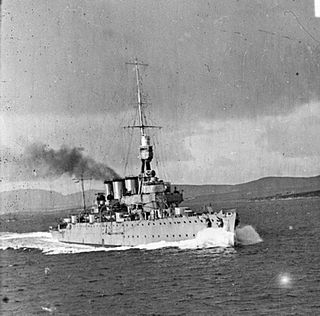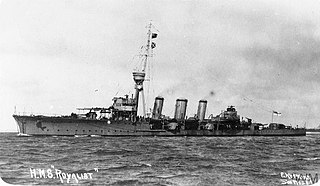
The M29 class comprised five monitors of the Royal Navy, all built and launched during 1915.

HMS Arethusa was the name ship of her class of eight light cruisers built for the Royal Navy in the 1910s. She saw a considerable amount of action during the early years of the First World War, participating in the Battle of Heligoland Bight and the Battle of Dogger Bank.

HMS Chester was a Town-class light cruiser of the Royal Navy, one of two ships forming the Birkenhead subtype. Along with sister ship, Birkenhead, she was originally ordered for the Greek Navy in 1914 and was to be named Lambros Katsonis. The order was placed with Cammell Laird and production continued for the Greek account after the outbreak of the First World War in August 1914. In 1915 the two cruisers were purchased by the British government. She fought at the Battle of Jutland where casualties included John 'Jack' Cornwell who was awarded the highest honour, aged 16.

HMS Inconstant was one of eight Arethusa-class light cruisers built for the Royal Navy in the 1910s. She fought in the First World War, participating in the Battle of Jutland. Following the war, she was scrapped.

HMS Phaeton was one of eight Arethusa-class light cruisers built for the Royal Navy in the 1910s. She fought in the First World War, participating in the Battle of Jutland. Following the war, she was scrapped.

HMS Royalist was one of eight Arethusa-class light cruisers built for the Royal Navy in the 1910s. She fought in the First World War, participating in the Battle of Jutland. Following the war, she was scrapped.

HMS M31 was an M29-class monitor of the Royal Navy.
HMS M28 was a First World War Royal Navy M15-class monitor. She was sunk during the Battle of Imbros in 1918.
HMS M27 was a First World War Royal Navy M15-class monitor. She was also served in the British intervention in Russia in 1919, and was scuttled in the Dvina River on 16 September 1919.
HMS M25 was a First World War Royal Navy M15-class monitor. She was also served in the British intervention in Russia in 1919, and was scuttled in the Dvina River on 16 September 1919.
HMS M26 was a First World War Royal Navy M15-class monitor.

HMS M21 was a First World War Royal Navy M15-class monitor. After service in the Mediterranean and the Dover Patrol, she struck a mine off Ostend in January 1918 and sank off Dover.
HMS M20 was a First World War Royal Navy M15-class monitor.
HMS M19 was a First World War Royal Navy M15-class monitor.
HMS M22 was a First World War Royal Navy M15-class monitor. Later converted to a minelayer and renamed HMS Medea, she was wrecked whilst being towed for breaking up on 2 January 1939.
HMS M23 was a First World War Royal Navy M15-class monitor. After service in the Mediterranean and the Dover Patrol, she was also served in the British intervention in Russia in 1919. Converted to the RNVR drillship Claverhouse in 1922, she served in that capacity at "Leith" until 1958.
HMS M24 was a First World War Royal Navy M15-class monitor. After service in the Dover Patrol, she was also served in the British intervention in Russia in 1919. She was sold in mercantile service in 1920.
HMS M18 was a M15-class monitor built for the Royal Navy during the First World War.

HMS M17 was a First World War Royal Navy M15-class monitor.

HMS M15 was a First World War Royal Navy M15-class monitor. She was sunk off Gaza by UC-38 on 11 November 1917.









